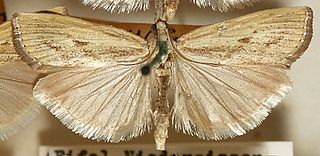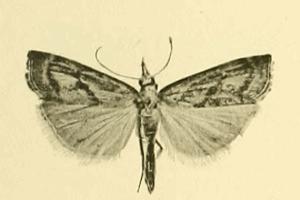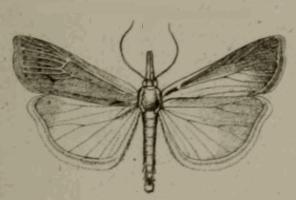
The Crambidae are the grass moth family of lepidopterans. They are variable in appearance, the nominal subfamily Crambinae taking up closely folded postures on grass stems where they are inconspicuous, while other subfamilies include brightly coloured and patterned insects which rest in wing-spread attitudes.

Agriphila inquinatella is a small moth species of the family Crambidae. It is found in Europe, around the Caucasus area to Turkestan, and in the Near East to Jordan. The type locality is in Austria.

Agriphila straminella is a species of moth of the family Crambidae. It was described by Michael Denis and Ignaz Schiffermüller in 1775 and is found in Europe and east across the Palearctic.

Agriphila tristella, the common grass-veneer, is a species of moth of the family Crambidae found in Europe and Asia.

Agriphila is a genus of small moths of the family Crambidae. It was first described by Jacob Hübner in 1825. They are common across temperate Eurasia and in adjacent regions.

Agriphila deliella is a species of moth of the family Crambidae. It is found in most of Europe and North Africa and from Anatolia to Afghanistan.

Pediasia contaminella is a species of moth in the family Crambidae described by Jacob Hübner in 1796. It is found in almost all of Europe, Asia Minor, the Caucasus, Transcaucasia, Iraq, Iran, the Kopet Dagh and Minusinsk.
Agriphila aeneociliella, the eastern grass veneer, is a species of moth in the family Crambidae. It is found from Denmark, Poland, Ukraine and Romania through Russia to Manchuria, northern China, Korea and Japan.
Agriphila beieri is a species of moth in the family Crambidae described by Stanisław Błeszyński in 1953. It is found on Crete and Cyprus, as well as in Russia, Turkey, Syria, Iraq and Iran.
Agriphila biarmicus is a species of moth in the family Crambidae first described by Johan Martin Jakob von Tengström in 1865. It is found in Fennoscandia, north-western Russia, Estonia, Latvia and in the Alps of Switzerland, Austria and Italy. It is also found in Canada, including Alberta and Quebec.

Agriphila brioniellus is a species of moth in the family Crambidae described by Hans Zerny in 1914. It is found in Spain, France, Italy, Croatia, Hungary, Slovakia, Ukraine, Romania, Bulgaria, the Republic of Macedonia, Albania, Turkey, Transcaucasia and Iraq.
Agriphila cyrenaicellus is a species of moth in the family Crambidae. It is found in southern Europe; in the Middle East; in northern Africa; and in Central Asia.
Agriphila dalmatinellus is a species of moth in the family Crambidae that is known from Europe and Asia. Within Europe, it is found in Croatia, Bosnia and Herzegovina, Italy, Bulgaria, the Republic of Macedonia and Greece. In Asia, it is known from Cyprus, Iran, Iraq, Syria and Samarkand.

Agriphila tersellus is a species of moth in the family Crambidae. The species was described by Julius Lederer in 1855. It is found in Spain, Portugal, France, Italy, Austria, Croatia, Slovakia, Hungary, Romania, Bulgaria, Greece, Morocco, Algeria, Tunisia, Asia Minor, Turkmenistan, Syria, Lebanon, Iran and Transcaucasia.
Agriphila indivisellus is a species of moth in the family Crambidae described by Turati and Zanon in 1922. It is found on Crete and in North Africa.
Agriphila paleatellus is a species of moth in the family Crambidae described by Philipp Christoph Zeller in 1847. It is found in Croatia, Bosnia and Herzegovina, Greece, on Sicily and in Asia Minor and Syria.

Agriphila tolli is a species of moth in the family Crambidae. It is found in Ukraine, Romania, Bulgaria, Turkey, Greece, the Republic of North Macedonia, Albania, Montenegro, Hungary, Slovakia, the Czech Republic, Austria, Italy and on Corsica, Sicily and Crete.
Agriphila trabeatellus is a species of moth in the family Crambidae. The species was described by Gottlieb August Wilhelm Herrich-Schäffer in 1848. It is found in France, Spain, Portugal, Italy, Greece and on Corsica, Sardinia, Sicily, Malta and Crete, as well as in Asia Minor, Lebanon, Algeria, Libya and the Canary Islands.
Agriphila bleszynskiella is a moth in the family Crambidae. It was described by Hans Georg Amsel in 1961. It is found in Iran, Afghanistan, and Turkey.
Agriphila microselasella is a moth in the family Crambidae. It was described by Stanisław Błeszyński in 1959. It is found in Iran.







